
home
 |
Palästina
- Israel home |
PalisD |
|
My third visit to Gaza
April 21 to May 3, 2012 Peter Voss 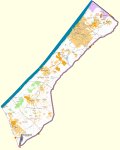 Gaza maps: 'OpenStreetMap', 'destruction'; 'no-go'; 'satellite': Google Earth oder Google Maps, else (28 MB) As early as 2010, I came across information which reported that part of the rural population was still worse off than the refugees served by UNRWA. During my visit to Gaza in 2010, I tried with UNRWA (United Nations Relief and Works Agency) and OCHA (Office for the Coordination of Humanitarian Affairs) to find a report on this issue, but without success. I mentioned this in my report. Last year I had planned to have another attempt on this subject, but because of the tight surveillance of the group of visitors nothing was possible in this direction. This time I could pick up the thread again. I wanted to determine first hand how the situation of the refugees was in general. In addition the idea was resolved that I would try to trace the life of a refugee family through a day. It was clear that it would probably be difficult to find such a family that would be willing to accept this. And because I would hardly be able to communicate in English, an accompanying translator also had to be lined up. Before I report about how much I succeeded with my project, I would like to give an introduction on the situation in which the refugees live. I will repeat some of the things that I described in my report of 2010. General Information According to data of the Statistical Office of the Palestinian Authority in the middle of 2011, 1.59 million people lived in the Gaza Strip, i.e. by mid -2012 there must have been about 1.65 million. Forty four per cent of the population are under 14 years old, while 2.4% are older than 65 years (i.e. in this environment I was already at a very advanced age). The average number of children per family in the Gaza Strip in 2010 was 5.6 children. In 2011 there were approximately 246 000 households. In the Gaza Strip 69.2% of the male population and 17,3% of the female population over 15 years are attributed to the labor force. Of these a total of 40,3% were available for the labor market. And of these 28,4% were unemployed (data of August 2012). In the Emergency Appeal of UNRWA the following numbers are given for Gaza (p. 5): 1,454,032 inhabitants, of whom 1,20485 million are refugees; 523,111 of these live in camps. The rest of the population thus comes to 249,182, i.e. according to these data it amounts to less than 20% of the total population. UNRWA also gives numbers for the labor market for the first half of 2011.
Almost 60% have given up hope of finding a job or are otherwise not available. Charities To enable people in the Israeli-occupied territories to survive - which is really the task of the occupying power - there are a number of organizations whose activities since 2003 are summarized under the title "Consolidated Appeal". Here are some details from the Consolidated Appeal 2012 (144 pages) for the occupied Palestinian territories: There are 59 organizations involved with the aid projects (p. 7). The budget proposals range from $ 100,000 to $ 222 million. The organisation with the largest budgets are: CARE (Cooperative for Assistance and Relief Everywhere) International) with $ 7,388,000, OCHA (United Nations Office for the Coordination of Humanitarian Affairs) with $ 7,491,639, FAO (Food and Agriculture Organization of the United Nations) with $ 8,960,000, ACF (Action Contre la Faim) witht $ 10,274,034, UNICEF (United Nations Children's Fund) with $ 13,312,904, WFP (United Nations World Food Programme) with $ 83,812,888 und UNRWA (United Nations Relief and Works Agency) with $ 221,839,975. The appeal for 2012 includes a diagram for CAP 2011 (p. 27), from which one can see how much funding was actually provided. Originally, apparently $ 575 million were requested, i.e. the under-funding was even greater. 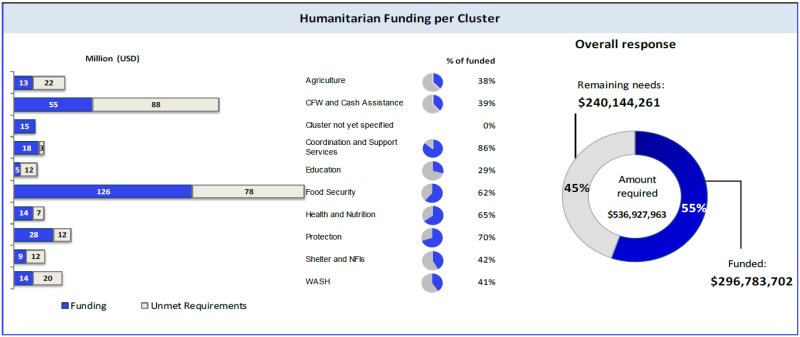 If one calculates the real amounts from the given figures, one arrives at the figures in the table. Food security makes up nearly half the budget. In the small proportion for education, major parts were for construction projects, of which there were very few in Gaza. Protection included legal, psychological and social support as well as escorting.
The real part was calculated by me. For the CAP 2012, the sum of the requested funding was reduced to $ 417 million, although the need is probably hardly getting any smaller. In April 2012, the coverage was 43%. The money is intended to assist 1.8 million people, i.e $ 232 per person per year. In real terms with 50% allocation it amounts to $ 116 per year. Of these approximately 45% are for food security, i.e., $ 52 per person per year. this makes for an average of $ 0.14 per person per day, with only 1.34 million people receiving such support. Therefore, the program participants get a little more. The $ 222 million listed above as the request of UNRWA do not represent the entire budget of UNRWA, because not all of UNRWA's activities are included in the CAP. This is partly due to budget items such as 'direct financial support' for which apparently from experience it is known that there will be no money left, and which one therefore has removed from CAP, but drags along in the UNRWA Emergency Appeal (EA 2012, p.20). The Emergency Appeal has a size of $ 301 million. In 2011 375 million were requested. Because of the aforementioned conditions the percentage of the funds received was with 40 % even less than for CAP. For 2012 the request was further reduced, possibly in the hope that the relation would improve somewhat. 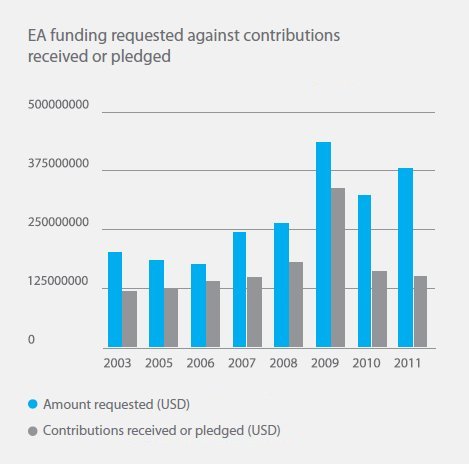 The average household in Gaza had an income of 680.7 Jordanian dinars, or about 750 euros per month, of which 42.5% was spent on food (Palestinian Central Bureau of Statistics). I have found no information on income distribution, which I expect to be quite extreme. The Palestinian Authority lists for the whole of Palestine thresholds for defining poverty and extreme poverty, based on a household with two adults and three children (sometimes apparently with four children). They amount to U.S. $ 609 (approx. € 470) per month, i.e. $ 4 per person per day, and about U.S. $ 478 (€ 370) per month, i.e. $ 3.1 per person per day, respectively. Measured on this scale, 38.1% of households in Gaza were poor and 23% were extremely poor in 2010, i.e. a total of more than 60% were at least poor. The UN uses in part a slightly different definition: UNRWA (EA 2012, p.22) defines 'absolute poor' at $ 4 per person per day and 'abject poor' at $ 1.6 per person per day. As of 2009 49.9% are listed as absolute poor and 18.7% as abject poor, where in both groups the percentage of non-refugees is higher than that of the refugees, probably indicating the extreme poverty of part of the rural population. The World Food Programme apparently has only one category: 'extremely poor' at less than $ 2.7 per person per day. This affects about 285,000 persons in Gaza (see below), more than the number of the UNRWA in Gaza non-refugees (242.000, EA 2012, p.5), i.e. there must be some overlapping support. According to a report by the World Bank (part 1, Figure 15, no numbers) from the year 2009 health care is significantly better and life expectancy is significantly higher than in countries with comparable poverty such as Egypt. This is certainly a direct or indirect effect of the work of the relief organizations. In order to get an idea of purchasing power at least for basic food items, I have tried to find some information for these. There are huge amounts of data on the change of price indexes. But I have found almost nothing about actual prices. If there are such values, it is usually no indication of the reference amounts. I found some information in an overview of the World Food Programme to Gaza in 2011. There one learns that bread is sold in bags for 7 Israeli Shekels (NIS) each, i.e. over time the price does not change, but the amount. Flour, rice and sugar are sold in bags of different sizes. I have found clear information only for flour, bread and beef. I have averaged and rounded monthly data over a year. The figure for rice is probably for a 25 kg bag. A student in Gaza (Yaser) did a data collection with reference units for me in August 2012.
Bread is cheap. The caloric content of sugar is not specified. The diet is based essentially on flour products. I quote here again as in my report from 2010 from the minutes of a meeting of the Munich City Council in 1947: "For the real value of the food, not the calorific value, expressed in calories, is of importance, but the content of protein and fat. From bread alone – and this can be any quantity – a human can not survive." UNRWA and the World Food Programme (WFP) As can be seen from the above listing, UNRWA and the World Food Programme (WFP) have the main responsibility for the care of the poor population in Gaza. Both are agencies of the United Nations. As the name already expresses, UNRWA is responsible solely for the Palestinian refugees, while the WFP operates worldwide. For both organizations there are articles on Wikipedia. UNRWA was established on 05/01/1950 for the care of Palestinian refugees and their descendants. Its headquarters is located in Gaza. The WFP takes care of the non-refugee part of the needy population In Gaza. An idea under which guidelines and under which conditions these organizations work provide reports and requests of these organizations. Of these I have compiled some of the details (UNRWA, WFP). The fate of poor families is also made public in the Internet through private aid agencies. Videos (video 1, video 2) show such examples with a bit more detail to about the extent to which I wrote about the families in Shijeaya. In addition to the nutrition and housing problems there is also the problem of psychological distress. On 07/11/2012 this was treated in an article of the Oxfam staff member Anne Robson in The Guardian. On 07/30/2012 she also treated the particular problems that women have under these conditions. With me at some time the idea had settled that I would like to make an attempt to report more closely on the daily routine of such a family. It was clear from the outset that such a report could just be a coincidental product. I had absolutely no idea how I could impose myself on such a family and what the possible result of such a visit would be. I took it for granted that I would need a translator. My idea was to follow a family who had just picked up its three-month ration and try to start a conversation. Such a freshly supplied family would certainly not have been a typical example. As had occurred several times before, a chance encounter led to another development. This happened when I went to the food distribution center at the Beach Camp in Gaza City, where I hoped to get some information about the size of the issued rations. This turned out not to be so easy because I was met with considerable suspicion. I was asked to obtain an official permit. I felt that with hundreds of thousands of beneficiaries these amounts could actually not be a big secret. Fortunately I still had the telephone number of the UNRWA spokesperson from my first visit, who this time was very helpful (and I therefore would like to express my gratitude here). Even with his advocacy the resistance still remained. An approval by a second person was asked for. Hearing this I became a little impatient. I do not know what finally led to a turnaround. It certainly helped that I could tell of my blockade experiences in Berlin during my childhood. At any rate, the mood changed completely, it became very friendly and I got a list of the different quantities depending on family size. I will quote here only one special case. While we were talking about the three-month rations, totally unexpected for me and shocking, the head of the center mentioned that these rations would last only for half the time. When I asked what people were doing the rest of the time, she said: "They drink tea." On this occasion I mentioned my desire to have the opportunity to visit a family from the poverty-stricken class. To my surprise, a social worker, who had quietly listened to the conversation all the time, told me that he could probably help me. He was thinking of a particular family, which he would ask. My visit to the farmers in Shijaeya took place during the time when I was waiting for the consent of the family. After this visit I suddenly realized that I wanted to visit the family without a translator, because I wanted to observe a normal family life with as little interference as possible. Of course, it still could not be avoided that I would affect the daily routine of such a family in one way or another, for who can just ignore a totally alien stranger who is hanging around in their apartment for hours. Family F. agreed to my plan. I met Mr. F. and the social worker showed me the way to the apartment which I would need to find by myself the next day early in the morning. It was a family of seven children, three daughters and four sons, the eldest of whom was married already, i.e. he no longer lived at home. When I visited they were in the "tea" phase. That was pretty much all I knew before and during my visit to the family. The three-month ration of UNRWA for such a family of eight according to the list is specified to 180 kg of flour, 21 kg of rice, 21 kg of sugar, 16 portions of 340g canned meat, i.e. approximately 7.5 g of tinned meat per person per day and 8 kg of milk powder which will make about 80 liters of milk. Later I learned that the family also received 300 NIS (about € 60) for three months in cash. The
situation
of a family of ten supported by UNRWA was described by Peter
Münch
in the Süddeutsche Zeitung of 07/30/2010 (Hoffnungsstreifen).
It seems that the flour ration was larger then and the meat ration
smaller.
An abjectly poor
family
I rode my bike over to the refugee camp and arrived
at family F.'s house at 5 minutes past six clock. Part of the
family was already awake. The two younger girls were getting ready for
school. I soon realized that two of the children, the oldest daughter
and the third oldest son (the second still living at home) did not want
to be seen or filmed, respectively. During my whole stay during the morning the
daughter left the bedroom only briefly with her face covered. The rest
of the family I was able to film. The next day Ms. F. told me that
she did not want her face displayed in any global publication. This did
not hold for local presentations. For this reason I decided not to
publish any video scenes and the photos shown here I selected so that
one can not recognize Ms. F's face, sometimes by darkening or obscuring
it.The unemployed head of the household was certainly in a very uncomfortable position, because during the time when the children had left the house he could not leave me alone with his wife. He went out of the house only for a few minutes, hung out most of the rest of the time in the living room and probably did not really know in which corner he should stay. Family F. lives in a kind of house that in L-shape is squeezed between higher buildings. Parallel to an L-leg is a narrow courtyard with the entrance. Bordering on the inside there was the living room, a kitchen and a toilet area behind it. In the remaining second leg of the L was the bedroom. All I can say from personal experience is that the two elder sons were sleeping in the living room and the older girl and the two and a half year-old son in the bedroom. The house consisted of concrete blocks unplastered on the outside. The inside was plastered, in many places covered with chipped paint layers in which the moisture in part had crept up almost to the ceiling. The ceiling consisted of opaque or translucent corrugated sheets and was not lined on the inside. The living room had a door and two windows, the kitchen seemed to be illuminated only through the roof and the bedroom had apparently no natural light. The end of April it was already quite warm during the day, and so I wore only sandals. Thus I realized after a while that the living room was extremely cold for the feet. Ms. F. again and again wrapped herself in a blanket. During my stay there I moved only within a very narrow range, from the front door about 1.5 m into the room where I spent most of time sitting in a chair, occasionally moving to the kitchen section next to the entrance, and at a time where I was not yet aware of the problem with the oldest daughter, I had a quick glance into the bedroom and in the toilet area, separated only by a curtain,. On that day a lot of laundry was hanging out to dry in the courtyard. There was also a water tank and a tangle of partly leaky water pipes coming down from the roof, furthermore a rusted metal box, which was later explained to me to be a bread oven, and a long washboard. I filmed almost exclusively. At the kitchen, which that early in the morning was only very weakly lit, I used an LED light, that was far too weak for the living room, but there the lighting was fortunately not as critical at this time of the day. My camera had the somewhat unpleasant property that when closing the lid it did not shut down, something that I was used to sofar. Thus it happened twice that in phases, which I considered as being fairly important, I switched to pause instead of starting the recording. As mentioned before, family F. was in the 'tea' phase, i.e. there was nothing to notice of the UNRWA food aid assistance with the possible exception of a 1-liter bottle of oil. From the videos I have selected some extracted photos that show the home environment, and some photos that complement the description of my observations. I am describing a brief glimpse into a part of the daily routine of a very poor family among ten thousands of families living in refugee camps in Gaza. Some refugees live - at least judging by the facades of the houses - noticeably better. The most prominent among camp residents in the Beach Camp is Prime Minister Ismael Haniyeh. 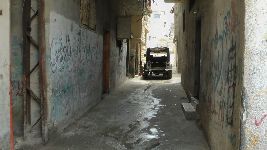 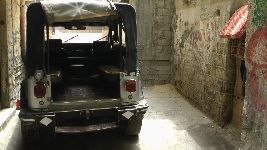 Access to the house, next to the car to the right, the outside wall of the living room and the wall of the courtyard. 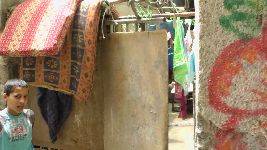 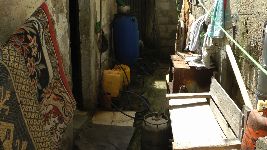 The entrance and the courtyard, taken a day later. In the courtyard to the right in front the washboard and behind it the bread oven. The visit 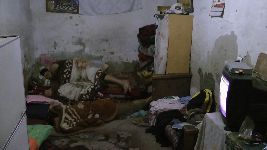 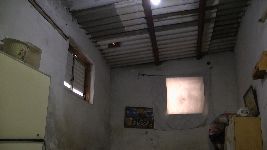  The living room: The first image was taken shortly after 6 clock. The two older sons are still sleeping in the back of the room. The other two photos were taken 2.5 hours later. They show the roof construction. The left window was not opened until late morning. 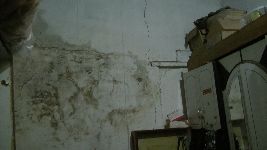 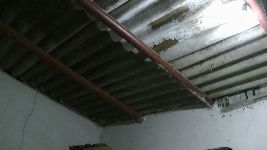 A look into the bedroom. On the left below was a large bed, where the oldest daughter and the youngest son were still asleep. In the second photo one can see to the right of the middle part a window, which was apparently part of the house next door and built over. When I arrived the girls were already up. The mother was combing their hair. The father is diabetic and one of the girls gave him a shot in the arm. 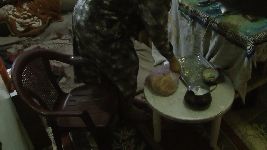 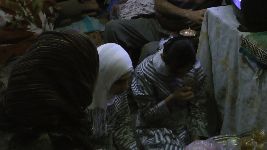 Ms. F. prepared breakfast in the kitchen and mother and daughters sat down on the ground around the small table in the living room. Breakfast consisted of bread and apparently only satar (thyme). There was also a bowl with some falafel on the table. The mother divided a piece of bread, filled it with some Satar and distributed it to the girls. As much as I could see this was all they ate. In addition there was tea. The girls left the house around 6:30 clock. 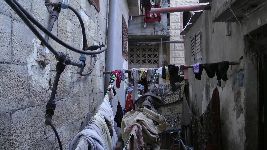 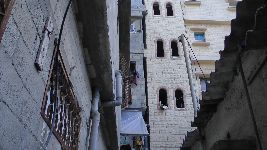 I went out into the courtyard and shot in the direction towards the entrance, 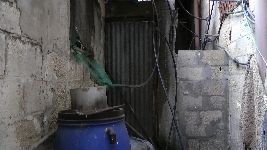 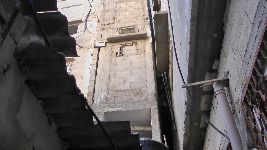 and then in the opposite direction. When seen from the outside the kitchen seemed to have a window after all. 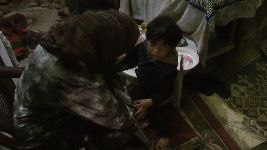 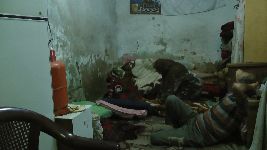 At 6:30 the second-oldest son got up. He did not want to be filmed. He grabbed some falafel and disappeared after a short time. The mother took the little boy out of the bedroom and laid him on the mattress lying on the floor, where until then the elder son had slept. The boy was tired, wanted to sleep, but was restless. The mother sat down beside him and put her hand on his chest in silence, while there was a matching background sound from the TV of soporific religious music. For me it was a very touching image. 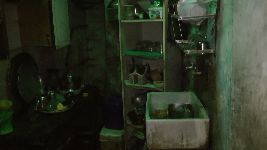 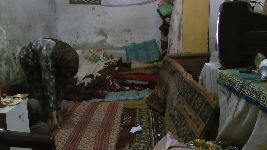 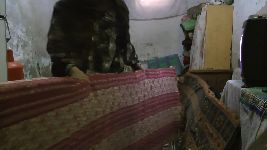 Ms. F. began her morning's work. She washed the dishes, picked up the rugs lying in the kitchen, rinsed them off and wiped the floor with a lot of water. The kitchen had a sink, which apparently had no outlet. The drain was located on the floor in front of the sink, usually covered by a board. 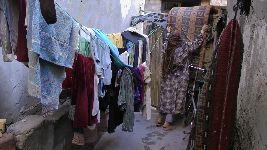 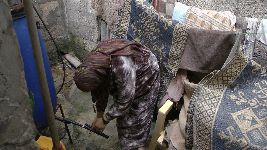 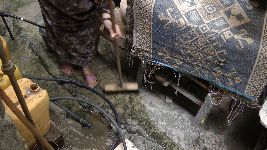 She then proceeded by picking up some mattresses from the living room floor and carrying them out to be aired. She put them over the outside wall (where my bike was standing). Then she proceeded to sweep out the ground of the courtyard. Shortly before 7:30 the oldest son got up. He stayed only a short time and left the house without having eaten anything and taking no food along. He was a little overweight, though. We met later again under completely different circumstances (as bystanders during a marriage procession). 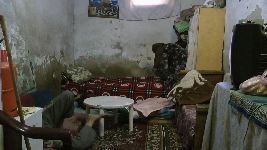 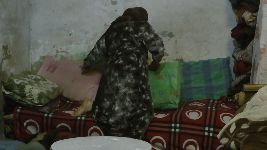 The woman of the house now rearranged the living room and put up some pillows against the rear wall. 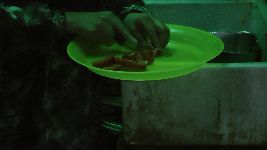 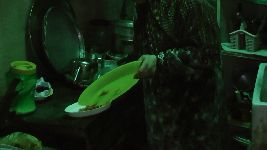  She then prepared breakfast for her husband and herself from tomatoes and some greens . She had no work table in the kitchen area and had to work on the edge of the kitchen basin. After dinner, they both had some time to watch TV and for conversation. 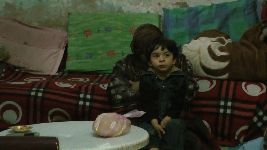 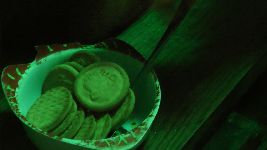 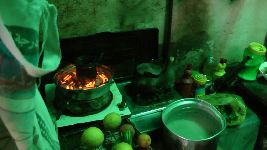 At 9:10 clock the little boy woke up. The second son turned up shortly and brought some cigarettes for his father and a package of biscuits. The mother put the biscuits in a bowl and heated a small pot of water. There was a gas cooker in the kitchen that did not seem to function and on top of it was a rather adventuresome electic heater, basically probably not so unusual. This hot plate was marked, though, by the fact that a bent grid was on top of it, which came frighteningly close to the exposed heating coils. 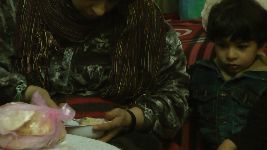 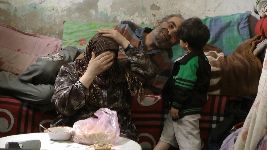 The boy had been gnawing on a piece of bread for some time. The mother now prepared some mush from the biscuits with the heated water, which the boy refused to eat after the first spoonful. He preferred to stick to his piece of bread. 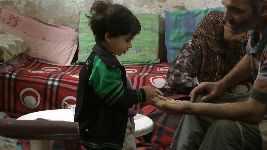 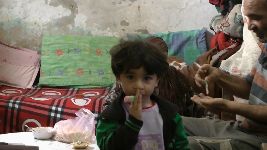 Sweet things did not seem particularly attractive for the boy. The father offered him some gummi bears, but that triggered no great enthusiasm. Against 10:20 o'clock the father went outside with the boy for a short time. During this time the mother was busy with folding and storing the laundry. She then visited the daughter in the bedroom. The father later also went in to see her. Now there began a period in which there was not much for me to film. I took a short walk over to the UNRWA distribution point. After my return there was an attempt at a conversation. Mr. F. showed me a letter addressed to UNRWA, in which he solicited any job, even if it were not paid. They could do nothing for him. He had previously had a job and lost two fingers in a work accident. That was all I could understand during this gesture communication. 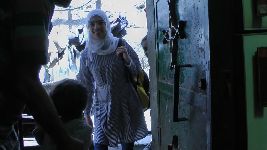 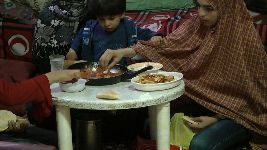 Around 12:30, the second son and the girls came home. They brought something like chips and for the little boy a box of milk chocolate. The mother had prepared a meal of tomatoes and french fries for the girls. 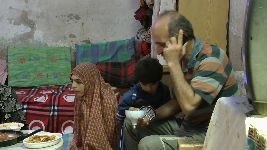 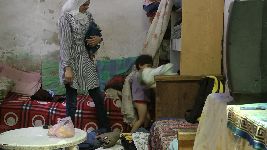 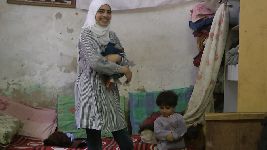 There were a few observations on the side. The little boy had gotten hold of an LED lamp, a device with a lamp socket and a backup battery in order to have some light during power cuts. The boy tried out how much knocking against a wall the device could stand. In the photo he looks very interestedly at the disassembled parts in the hands of his father. After the father had been trying for some time to put the pieces together again, I was proudly able to show my puzzle-solving and electrician's skills. The last two photos may show something about the role allocation, which is apparently internalized early on. The boy decided to remove everything from the cabinet that his mother had just put in arduously. The big sister was standing by until everything was emptied and apparently thought it was pretty funny. Shortly after 19 o'clock I went over again. There was still some daylight, but the apartment was completely dark, as there was a power cut. The little boy was carrying the LED lamp around, which did not give much light anyway, and my camera light was not nearly in a position to illuminate the room. The most useful light came from two candles that were lit by the man of the house. Father, mother and two daughters sat in the back of the room around the little table and ate a supper consisting of bread with some satar, a few olives, and what seemed to be a small remainder of the tomato lunch. In addition there was an orange drink. I only stayed for about 20 minutes. The next day there was a follow-up conversation, but unfortunately at a rather bad time, so that the conversation was very brief. The given conditions did not allow for a second interview. I learned that the family received eight bags of flour (as the flour rations are graduated in 30 kg steps, I would have expected six sacks according to the above figures). The three-month rations would last for 1 1/2 to 2 months. The additional approximately NIS 300, which equates to about € 20 per month cash, I have already mentioned. When asked how they could survive for the rest of the time, they told me that they would get support from the mosque and also help in small amounts by good people. One of the two plastic chairs (worth about € 7) was broken. I wondered how difficult it would be to replace it. Ms. F. said if she had the choice but to buy a mattress for the boy or a chair, then she would naturally buy the mattress. Ms. F. was visibly suffering from the condition of the walls and pointed them out to me explicitly. I touched the outer wall of the living room. It did not seem to be moist, but one could see the remains of many layers of paint and spaces where pieces had fallen out. Ms. F. also mentioned how the living conditions stressed her with respect to her children. 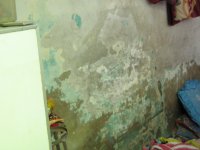 the living room wall
the living room wallI would have had more questions, e.g. about the electricity, water and gas supply. Since this is a general problem, I assumed that such information would be easy to get even later. This was not confirmed, however, and I now believe that one will get no clear answer concerning these issues. It is known that many utility bills are not paid, which is another reason for the blackouts. My host told me that for salary earners the invoice amount is directly deducted at source. Under the given circumstances of life, one can not block the electricity supply for everybody who has not paid the bill. It may well be that in some cases it may not be all that easy to determine who the consumer is. |